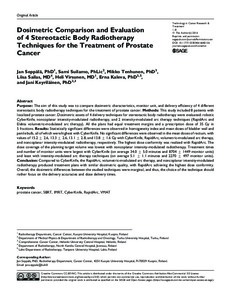Dosimetric Comparison and Evaluation of 4 Stereotactic Body Radiotherapy Techniques for the Treatment of Prostate Cancer
Sami Suilamo; Heli Virsunen; Mikko Tenhunen; Liisa Sailas; Jan Seppälä; Erna Kaleva; Jani Keyriläinen
https://urn.fi/URN:NBN:fi-fe2021042716359
Tiivistelmä
Purpose: The aim of this study was to compare dosimetric
characteristics, monitor unit, and delivery efficiency of 4 different stereotactic
body radiotherapy techniques for the treatment of prostate cancer. Methods:
This study included 8 patients with localized prostate cancer. Dosimetric
assets of 4 delivery techniques for stereotactic body radiotherapy were
evaluated: robotic CyberKnife, noncoplanar intensity-modulated radiotherapy,
and 2 intensity-modulated arc therapy techniques (RapidArc and Elekta volumetric-modulated
arc therapy). All the plans had equal treatment margins and a prescription dose
of 35 Gy in 5 fractions.
Results: Statistically significant differences were observed
in homogeneity index and mean doses of bladder wall and penile bulb, all of
which were highest with CyberKnife. No significant differences were observed in
the mean doses of rectum, with values of 15.2+ 2.6, 13.3 +2.6, 13.1 +2.8, and
13.8 +1.6 Gy with CyberKnife, RapidArc, volumetric-modulated arc therapy, and
noncoplanar intensity-modulated radiotherapy, respectively. The highest dose
conformity was realized with RapidArc. The dose coverage of the planning target
volume was lowest with noncoplanar intensity-modulated radiotherapy. Treatment
times and number of monitor units were largest with CyberKnife (on average 34.0
+ 5.0 minutes and 8704 + 1449 monitor units) and least with intensity-modulated
arc therapy techniques (on average 5.1 + 1.1 minutes and 2270 + 497 monitor
units).
Conclusion: Compared to CyberKnife, the RapidArc,
volumetric-modulated arc therapy, and noncoplanar intensity-modulated radiotherapy
produced treatment plans with similar dosimetric quality, with RapidArc achieving
the highest dose conformity. Overall, the dosimetric differences between the
studied techniques were marginal, and thus, the choice of the technique should rather
focus on the delivery accuracies and dose delivery times.
Kokoelmat
- Rinnakkaistallenteet [19218]
